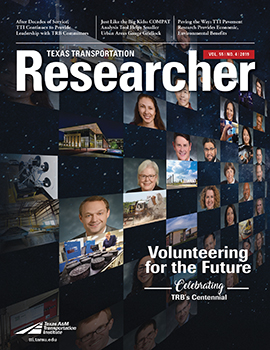The Texas A&M Transportation Institute (TTI) has a varied and productive history of applied research for the National Cooperative Highway Research Program. These projects provide excellent value by solving the myriad of problems facing transportation professionals. Two recent projects in the pavement area, Short-Term Laboratory Conditioning of Asphalt Mixtures and The Effects of Recycling Agents on Asphalt Mixtures with High RAS and RAP Binder Ratios, are summarized here.

Short-Term Laboratory Conditioning of Asphalt Mixtures
As roadway aging occurs, asphalt mixtures stiffen due to oxidation and other chemical processes. This makes them inflexible under vehicle loads; cracks begin to form, causing water to seep in, creating serious damage to the roadway. The ability to simulate aging in asphalt binders and mixtures in the laboratory has been studied extensively, and procedures have been adopted for use in binder specifications and mixture design.
“When we perform mix designs on asphalt in the laboratory, we heat the aggregate and asphalt and then blend them together,” explains TTI Senior Research Scientist David Newcomb. “Then we bring them up to temperature so they can be compacted, and then we test it. There’s a lot of uncertainty as to whether or not this accurately mimics what’s placed on the roadway.”
The research question was clear: how do we get our laboratory mix designs to reflect what’s actually being placed in the field? Researchers looked at two stages of aging — the initial aging during the production process and longer-term aging, which occurs as asphalt sits on the roadway.
“We examined a number of different U.S. projects as materials were produced, and we sampled the raw materials so we could test them in the laboratory at different aging phases,” said Newcomb. “Then we took materials produced in the field and brought those back to test them and see how well we were matching.”
The team discovered they could closely simulate short-term aging that occurs in a construction asphalt plant with what was done in a laboratory. They then examined longer-term aging, which for this project was about five years.
“We found that the laboratory aging did not do very well because the materials in the pavement aged more than they did in the lab,” notes Newcomb. “We tried various schemes of long-term aging in the laboratory and were finally able to mimic about 10 years of aging in the field.”
While researchers know there’s more work to be done — particularly involving how to get materials to represent long-term aging beyond 10 years in the field — the results provide better estimates, translating long-term asphalt aging in the lab into actual practice.
The Effects of Recycling Agents on Asphalt Mixtures with High RAS and RAP Binder Ratios
What’s not to like about the increased use of recycled materials in roadways? After all, it’s economically and environmentally beneficial to use higher recycled materials content in new asphalt mixtures — but only if it’s done correctly.
The recycled materials include reclaimed asphalt pavement (RAP) and, to a much lesser degree, recycled asphalt shingles (RAS). RAP is old pavement scraped up and recycled at a rate of 99 percent, making it the most reused product in the United States by far. Right now, most states only allow 20 to 25 percent of new asphalt mixtures to be RAP and 3 to 5 percent to be RAS.
“The reason states limit RAP content is that the material is brittle and aged, which can lead to cracking,” says TTI Research Engineer Amy Epps Martin. “One of the mitigation strategies to maintain engineering performance is to use a softer, virgin binder to try and double the maximum RAP content to 40 to 50 percent. The goal is to realize economic and environmental benefits without sacrificing engineering performance.”

The use of a recycling agent that partially restores the binder blend is a second mitigation strategy to control cracking.
With many types of recycling agents available on the market, TTI researchers developed a set of evaluation tools for the use of recycling agents with high RAS and RAP binder ratios.
“One of the things our research project yielded was a draft American Association of State Highway and Transportation Officials standard practice that includes methods to select appropriate component materials and rejuvenator dose, as well as to evaluate binder blends and mixtures,” explains Epps Martin. “Every combination of virgin asphalt binder, virgin aggregate, RAP, RAS and rejuvenator is unique and must be engineered to provide adequate performance.”

